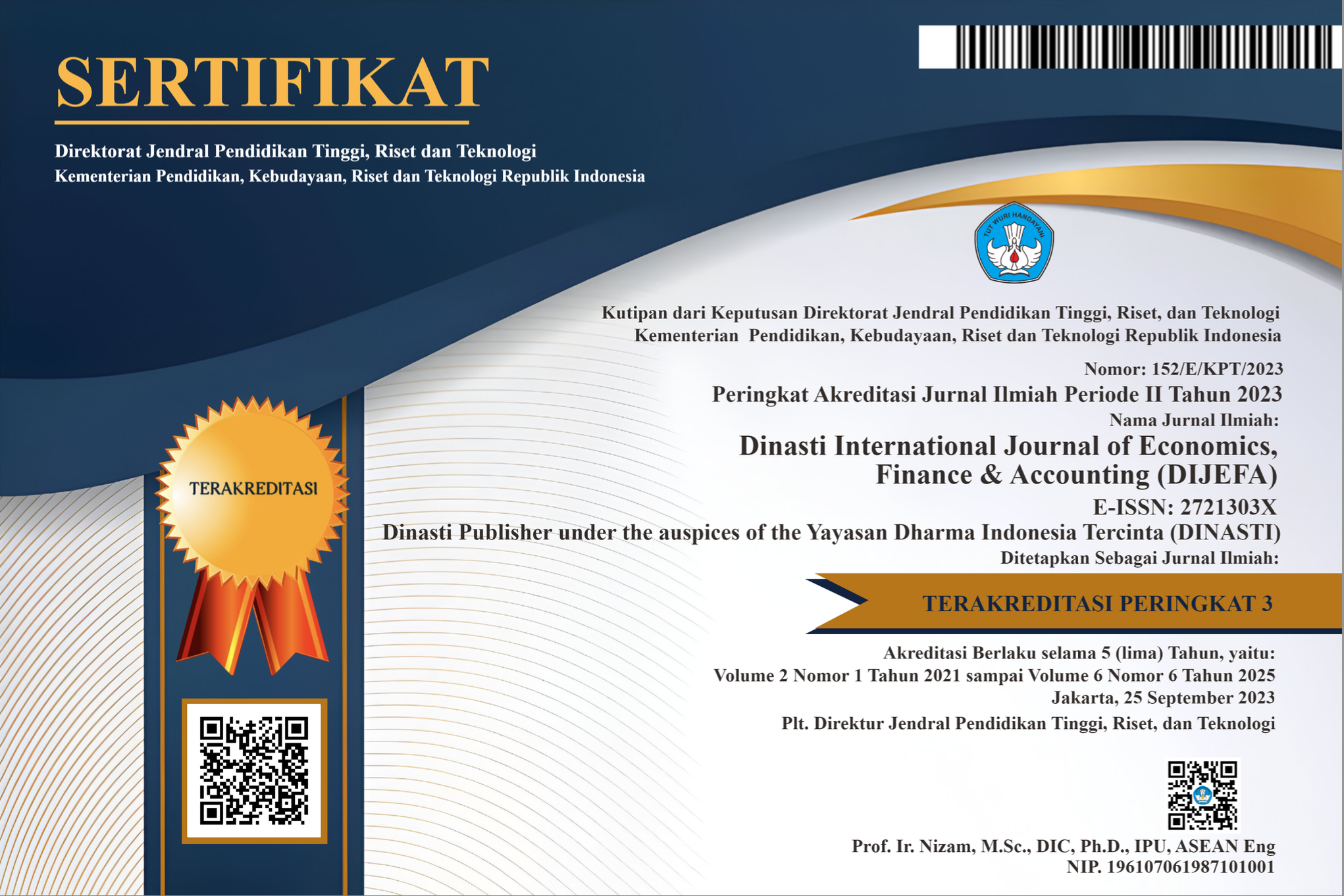Analysis Towards the Factors Relates to the Yield at Sharia Bond Which Listed on Indonesia Stock Exchange During Period of 2020
DOI:
https://doi.org/10.38035/dijefa.v2i6.1060Keywords:
DER, maturity, firm size, sharia bond rating, yield to maturity.Abstract
This research analyzes the influence caused by the debt equity ratio (DER), maturity, firm size and rating of Islamic bonds on the yield to maturity (YTM) from corporate Islamic bonds. The research population consisted of corporate sharia bonds traded at the Indonesia Stock Exchange during period of 2020. The sample choosen technique was performed by purposive sampling. The research sample consisted of 59 corporate bonds that issued from 13 companies through all sectors except the banking and financial sectors. The research analysis method used descriptive statistics and multiple linear regression. The outcomes showed partially that the maturity variable had a significant positive affect to YTM, Rating had a negative affect on YTM, while DER and Islamic bond ratings had no affect on YTM. The research implication stated that companies need to increase their sharia bond ratings in order to maintain investor trust. For further research, it is expected to analyze other variables which had an impact to YTM because the coefficient of determination that reached from this research are 67%, while the remaining of 33% was determined by other variables which not explained in this research.
References
Aisah, S. H., & Haryanto, M. (2012). Analisis Faktor-Faktor Yang Mempengaruhi Yield Obligasi Korporasi (Studi Kasus Pada Seluruh perusahaan Penerbit Obligasi Yang Terdaftar Di BEI Periode 2010- 2012. Diponegoro Journal of Accounting, 1(1), 1-12.
Baker, H. K., & Mansi, S. A. (2002). Assessing credit rating agencies by bond issuers and institutional investors. Journal of Business Finance & Accounting, 29(9‐10), 1367-1398.
Brigham, E. F., & Houston. (2006). Fundamental of Financial Management: Dasar-Dasar Manajemen Keuangan, Edisi 10. Jakarta: Salemba Empat.
Faizah, Y. L. N. (2019). Pengaruh Laverage Maturity dan Size Perusahaan Terhadap Yield Obligasi Dengan Peringkat Obligasi Sebagai Variabel Intervening. Journal of Economic, Management, Accounting and Technology (JEMATech), 2(1), 43-54.
Hamida, L. (2017). Pengaruh Likuiditas dan Leverage Terhadap Yield Sukuk dengan Peringkat Sukuk sebagai Variabel Intervening (Study Pada Perusahaan Non Keuangan di Bursa Efek Indonesia). Jurnal Ekonomi dan Bisnis, 18(1), 71-86.
Ibrahim, H. (2008). Pengaruh Tingkat Suku Bunga, Peringkat Obligasi, Ukuran Perusahaan Dan Der Terhadap Yield To Maturity Obligasi Korporasi Di Bursa Efek Indonesia Periode Tahun 2004-2006. Doctoral dissertation, Program Pascasarjana Universitas Diponegoro.
Indarsih, N. (2013). Pengaruh Tingkat Suku Bunga SBI, Rating, Likuiditas dan Maturitas terhadap Yield to Maturity Obligasi. Jurnal Ilmu Manajemen (JIM), 1(1).
Listiawati, L. N., & Paramita, V. S. (2018). Pengaruh Tingkat Suku Bunga, Inflasi, Debt to Equity Ratio, dan Ukuran Perusahaan terhadap Yield Obligasi pada Perusahaan yang Terdaftar di Bursa Efek Indonesia Tahun 2010-2016. Jurnal Manajemen, 15(1), 33-51.
Nurfauziah, N., & Setyarini, A. F. (2004). Analisis Faktor-faktor yang Mempengaruhi Yield Obligasi Perusahaan (Studi Kasus pada Industri Perbankan dan Industri Finansial). Jurnal Siasat Bisnis, 2(9).
Purnamawati, I. G. A. (2013). Pengaruh Peringkat Obligasi, Tingkat Suku Bunga-Sertifikat Bank Indonesia, Rasio Leverage, Ukuran Perusahaan Dan Umur Obligasi Pada Imbal Hasil Obligasi Korporasi Di Bursa Efek Indonesia. Vokasi: Jurnal Riset Akuntansi, 2(1).
Rahardjo, S. (2003). Panduan investasi obligasi. Jakarta: Gramedia Pustaka Utama.
Rahman, A. A., & Sam’aini. (2013). Analysis of Factors Affecting Government Bond Yields for 2010-2012. Jurnal Ekonomi Manajemen Akuntansi, 35, 1-16.
Restuti, M. I. M. D. (2006). Pengaruh pertumbuhan perusahaan terhadap peringkat dan yield obligasi. Doctoral dissertation, Universitas Gadjah Mada.
Sugiyono. 2013. Metode Penelitian Pendidikan Pendekatan Kuantitatif, Kualitatif, dan R&D. Bandung: Alfabeta.
Sukmaningrum, P. S., Rani, L. N., Hasib, F. F., & Rusmita, S. A. (2021). Impact Of Macroeconomics On Corporate Sukuk Yield In Indonesia. Review of International Geographical Education Online, 11(4), 418-429.
Surya, B. A., & Nasher, T. G. (2011). Analisis pengaruh tingkat suku bunga sbi, exchange rate, ukuran perusahaan, debt to equity ratio dan bond terhadap yield obligasi korporasi di indonesia. Jurnal Manajemen Teknologi, 10(2), 186-195.
Syakdiyah, K., & Putra, P. (2021). The Effect of Profitability, Liquidity, Leverage and Company Size on Sukuk Yield With The Rating of Sukuk as Intervening Variables. El-Qish: Journal of Islamic Economics, 1(1), 1-10.
Zuhrohtun, Z. B. (2006). The Effect Of Ratings Announcement On Bond Performance. Sosiosains, 19(2006).
Downloads
Published
How to Cite
Issue
Section
License
Authors who publish their manuscripts in this journal agree to the following conditions:
- The copyright on each article belongs to the author(s).
- The author acknowledges that the Dinasti International Journal of Economics, Finance & Accounting (DIJEFA) has the right to be the first to publish with a Creative Commons Attribution 4.0 International license (Attribution 4.0 International (CC BY 4.0).
- Authors can submit articles separately, arrange for the non-exclusive distribution of manuscripts that have been published in this journal into other versions (e.g., sent to the author's institutional repository, publication into books, etc.), by acknowledging that the manuscript has been published for the first time in the Dinasti International Journal of Economics, Finance & Accounting (DIJEFA).


























































